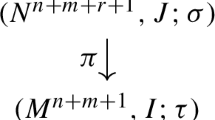Abstract
We study solutions of the “linear system in a saturated mode”
We show that a trajectory is in a constant face of the cubeD n on some interval (0,d]. We answer a question about comparing the two systems: (M) and
. As λ→∞, limits ofv corresponding to asymptotically stable equilibrium points of (H) are asymptotically stable equilibrium points of (M), and the converse is also true. We study the assumptions to see which are required and which may be weakened.
Similar content being viewed by others
References
S. Abe, Convergence acceleration of the Hopfield neural network by optimizing integration step sizes.IEEE Trans. Systems Man Cybernet.—Part B: Cybernet., 26, 194–201, 1996.
S. Abe and A. Gee, Global convergence of the Hopfield neural network with nonzero diagonal elements,IEEE Trans. Circuits Systems—II: Analog Digital Signal Process., 42, 39–45, 1995.
V. I. Arnold,Ordinary Differential Equations, MIT Press, Cambridge, MA, 1973.
H. Brezis,Operateurs Maximaux Monotones et Semi-groupes de Contractions dans les Espaces de Hilbert, North-Holland, Amsterdam and American Elsevier, New York, 1973.
J. J. Hopfield, Neurons with graded response have collective computational properties like those of two state neurons,Proc. Nat. Acad. Sci. USA, 81, 3088–3092, 1984.
J. H. Li, A. N. Michel, and W. Porod Qualitative analysis and synthesis of a class of neural networks,IEEE Trans. Circuits Systems, 36, 976–986, 1988.
J. H. Li, A. N. Michel, and W. Porod, Analysis and synthesis of a class of neural networks: Linear systems operating on a closed hypercube,IEEE Trans. Circuits Systems, 36, 1405–1442, 1989.
D. Liu and A. Michel, Asymptotic stability of systems operating on a closed hypercube,Systems Control Lett., 19, 281–285, 1992.
A. Michel, J. Si, and G. Yen, Analysis and synthesis of a class of discrete-time neural networks described on hypercubes,IEEE Trans. Neural Networks, 2, 32–46, 1991.
A. Pazy, Semi-gropus of nonlinear contractions in Hilbert space, inProblems in Nonlinear Analysis, ed. Prodi, Cremonese, CIME Varenna, 1971.
R. Perfetti, On the op-amp based circuit design of cellular neural networks,Internat. J. Circuit Theory Appl. 22, 425–430, 1994.
M. Vidyasagar, Location and stability of the high gain equilibria of nonlinear neural networks,IEEE Trans. Neural Networks, 4, 660–671, 1993.
M. Vidyasagar, Discrete optimization using analog neural networks with discontinuous dynamics, inInternational Conference on Automation, Robotics, and Computer Vision, Singapore, 1994.
M. Vidyasagar, Minimum seeking properties of analog neural networks with multilinear objective functions,IEEE Trans. Automat. Control, 40, 1359–1375, 1995.
M. Vidyasagar, Solution of difficult combinatorial optimization problems using analog neural networks with discontinuous dynamics, inInternational Conference on Automation, Robotics, Control and Computer Vision, Singapore, 1996.
P. B. Watta and M. H. Hassoun, A coupled gradient network approach for static and temporal mixed integer optimization,IEEE Trans. Neural Networks, 7, 578–593, 1996.
Author information
Authors and Affiliations
Rights and permissions
About this article
Cite this article
Calvert, B.D. Linear systems in a saturated mode and convergence as gain becomes large of asymptotically stable equilibrium points of neural nets. Circuits Systems and Signal Process 18, 241–267 (1999). https://doi.org/10.1007/BF01225697
Received:
Revised:
Issue Date:
DOI: https://doi.org/10.1007/BF01225697




